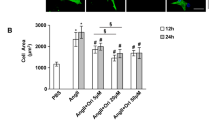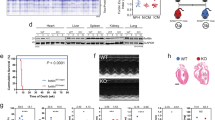Abstract
Autophagy, an evolutionarily conserved process for the bulk degradation of cytoplasmic components, serves as a cell survival mechanism in starving cells1,2. Although altered autophagy has been observed in various heart diseases, including cardiac hypertrophy3,4 and heart failure5,6, it remains unclear whether autophagy plays a beneficial or detrimental role in the heart. Here, we report that the cardiac-specific loss of autophagy causes cardiomyopathy in mice. In adult mice, temporally controlled cardiac-specific deficiency of Atg5 (autophagy-related 5), a protein required for autophagy, led to cardiac hypertrophy, left ventricular dilatation and contractile dysfunction, accompanied by increased levels of ubiquitination. Furthermore, Atg5-deficient hearts showed disorganized sarcomere structure and mitochondrial misalignment and aggregation. On the other hand, cardiac-specific deficiency of Atg5 early in cardiogenesis showed no such cardiac phenotypes under baseline conditions, but developed cardiac dysfunction and left ventricular dilatation one week after treatment with pressure overload. These results indicate that constitutive autophagy in the heart under baseline conditions is a homeostatic mechanism for maintaining cardiomyocyte size and global cardiac structure and function, and that upregulation of autophagy in failing hearts is an adaptive response for protecting cells from hemodynamic stress.
This is a preview of subscription content, access via your institution
Access options
Subscribe to this journal
Receive 12 print issues and online access
$209.00 per year
only $17.42 per issue
Buy this article
- Purchase on Springer Link
- Instant access to full article PDF
Prices may be subject to local taxes which are calculated during checkout




Similar content being viewed by others
References
Mizushima, N., Ohsumi, Y. & Yoshimori, T. Autophagosome formation in mammalian cells. Cell Struct. Funct. 27, 421–429 (2002).
Levine, B. & Klionsky, D.J. Development by self-digestion: molecular mechanisms and biological functions of autophagy. Dev. Cell 6, 463–477 (2004).
Dammrich, J. & Pfeifer, U. Cardiac hypertrophy in rats after supravalvular aortic constriction. II. Inhibition of cellular autophagy in hypertrophying cardiomyocytes. Virchows Arch. B Cell Pathol. Incl. Mol. Pathol. 43, 287–307 (1983).
Pfeifer, U., Fohr, J., Wilhelm, W. & Dammrich, J. Short-term inhibition of cardiac cellular autophagy by isoproterenol. J. Mol. Cell. Cardiol. 19, 1179–1184 (1987).
Shimomura, H. et al. Autophagic degeneration as a possible mechanism of myocardial cell death in dilated cardiomyopathy. Jpn. Circ. J. 65, 965–968 (2001).
Miyata, S. et al. Autophagic cardiomyocyte death in cardiomyopathic hamsters and its prevention by granulocyte colony-stimulating factor. Am. J. Pathol. 168, 386–397 (2006).
Kuma, A. et al. The role of autophagy during the early neonatal starvation period. Nature 432, 1032–1036 (2004).
Komatsu, M. et al. Impairment of starvation-induced and constitutive autophagy in Atg7-deficient mice. J. Cell Biol. 169, 425–434 (2005).
Hara, T. et al. Suppression of basal autophagy in neural cells causes neurodegenerative disease in mice. Nature 441, 885–889 (2006).
Komatsu, M. et al. Loss of autophagy in the central nervous system causes neurodegeneration in mice. Nature 441, 880–884 (2006).
Baehrecke, E.H. Autophagy: dual roles in life and death? Nat. Rev. Mol. Cell Biol. 6, 505–510 (2005).
Decker, R.S. & Wildenthal, K. Lysosomal alterations in hypoxic and reoxygenated hearts. I. Ultrastructural and cytochemical changes. Am. J. Pathol. 98, 425–444 (1980).
Yan, L. et al. Autophagy in chronically ischemic myocardium. Proc. Natl. Acad. Sci. USA 102, 13807–13812 (2005).
Nishino, I. et al. Primary LAMP-2 deficiency causes X-linked vacuolar cardiomyopathy and myopathy (Danon disease). Nature 406, 906–910 (2000).
Tanaka, Y. et al. Accumulation of autophagic vacuoles and cardiomyopathy in LAMP-2-deficient mice. Nature 406, 902–906 (2000).
Sohal, D.S. et al. Temporally regulated and tissue-specific gene manipulations in the adult and embryonic heart using a tamoxifen-inducible Cre protein. Circ. Res. 89, 20–25 (2001).
Kabeya, Y. et al. LC3, a mammalian homologue of yeast Apg8p, is localized in autophagosome membranes after processing. EMBO J. 19, 5720–5728 (2000).
Mizushima, N., Yamamoto, A., Matsui, M., Yoshimori, T. & Ohsumi, Y. In vivo analysis of autophagy in response to nutrient starvation using transgenic mice expressing a fluorescent autophagosome marker. Mol. Biol. Cell 15, 1101–1111 (2004).
Bjorkoy, G. et al. p62/SQSTM1 forms protein aggregates degraded by autophagy and has a protective effect on huntingtin-induced cell death. J. Cell Biol. 171, 603–614 (2005).
Hosokawa, N., Hara, Y. & Mizushima, N. Generation of cell lines with tetracycline-regulated autophagy and a role for autophagy in controlling cell size. FEBS Lett. 580, 2623–2629 (2006).
Nakagawa, T. et al. Caspase-12 mediates endoplasmic-reticulum-specific apoptosis and cytotoxicity by amyloid-beta. Nature 403, 98–103 (2000).
Boya, P. et al. Inhibition of macroautophagy triggers apoptosis. Mol. Cell. Biol. 25, 1025–1040 (2005).
Chen, J. et al. Selective requirement of myosin light chain 2v in embryonic heart function. J. Biol. Chem. 273, 1252–1256 (1998).
Yamaguchi, O. et al. Cardiac-specific disruption of the c-raf-1 gene induces cardiac dysfunction and apoptosis. J. Clin. Invest. 114, 937–943 (2004).
Lyons, G.E. et al. Developmental regulation of myosin gene expression in mouse cardiac muscle. J. Cell Biol. 111, 2427–2436 (1990).
Yamaguchi, O. et al. Targeted deletion of apoptosis signal-regulating kinase 1 attenuates left ventricular remodeling. Proc. Natl. Acad. Sci. USA 100, 15883–15888 (2003).
Wencker, D. et al. A mechanistic role for cardiac myocyte apoptosis in heart failure. J. Clin. Invest. 111, 1497–1504 (2003).
Hirotani, S. et al. Involvement of nuclear factor-κB and apoptosis signal-regulating kinase 1 in G-protein-coupled receptor agonist-induced cardiomyocyte hypertrophy. Circulation 105, 509–515 (2002).
Zhou, Y.Y. et al. Culture and adenoviral infection of adult mouse cardiac myocytes: methods for cellular genetic physiology. Am. J. Physiol. Heart Circ. Physiol. 279, H429–H436 (2000).
Mizushima, N. et al. Dissection of autophagosome formation using Apg5-deficient mouse embryonic stem cells. J. Cell Biol. 152, 657–668 (2001).
Acknowledgements
We are grateful to K. Chien (Harvard University) for the gift of MLC-2v Cre mice, J. Molkentin (Cincinnati Children's Hospital Medical Center) for MerCreMer mice, T. Yoshimori (Osaka University) for antibody to LC3 and E. Lakatta for teaching us to isolate adult mouse cardiomyocytes. This work was supported by a Grant-in-Aid for Scientific Research from the Ministry of Education, Culture, Sports, Science and Technology to K.O. (16590683). O.Y. held a postdoctoral fellowship from the Japan Society for the Promotion of Science. S.H. was the recipient of a postdoctoral fellowship from the Center of Excellence Research of the Ministry of Education, Culture, Sports, Science and Technology. T.T. received a postdoctoral fellowship from the Japan Health Science Foundation.
Author information
Authors and Affiliations
Contributions
A.N. worked on the in vitro analysis of the mice; O.Y. conducted the in vivo analysis of the mice and wrote the manuscript; T.T. performed adult cardiomyocyte isolation and Ca2+ transient experiments; Y.H. performed ischemia-reperfusion surgery; S.H. assisted with RT-PCR experiments; M.T., S.O. and I.M. contributed to the in vitro experiments; Y.M. performed statistical analysis of the data; M.A. contributed to Ca2+ transient measurements; K.N. contributed to the in vivo experiments; M.H. supervised this project; N.M. provided advice on designing and conducting experiments; K.O. conceived, designed and directed the study.
Corresponding author
Ethics declarations
Competing interests
The authors declare no competing financial interests.
Supplementary information
Supplementary Fig. 1
Inhibition of autophagy using adenovirus expressing shRNA against Atg7. (PDF 617 kb)
Supplementary Fig. 2
Characterization of Atg5flox/flox; MLC2v-Cre+ mice. (PDF 235 kb)
Supplementary Fig. 3
Pressure overload induces cardiac dysfunction in Atg5flox/flox; α-MyHC-Cre+ mice. (PDF 372 kb)
Supplementary Fig. 4
Autophagy in pressure overload-induced cardiac remodeling. (PDF 236 kb)
Supplementary Fig. 5
Biochemical analysis of Atg5flox/flox; MLC2v-Cre+ hearts after TAC. (PDF 287 kb)
Supplementary Fig. 6
β-adrenergic stress induces cardiac dysfunction in Atg5flox/flox; MLC2v-Cre+ mice. (PDF 627 kb)
Rights and permissions
About this article
Cite this article
Nakai, A., Yamaguchi, O., Takeda, T. et al. The role of autophagy in cardiomyocytes in the basal state and in response to hemodynamic stress. Nat Med 13, 619–624 (2007). https://doi.org/10.1038/nm1574
Received:
Accepted:
Published:
Issue Date:
DOI: https://doi.org/10.1038/nm1574
This article is cited by
-
Control of NAD+ homeostasis by autophagic flux modulates mitochondrial and cardiac function
The EMBO Journal (2024)
-
NADPH oxidase 2 mediates cardiac sympathetic denervation and myocyte autophagy, resulting in cardiac atrophy and dysfunction in doxorubicin-induced cardiomyopathy
Scientific Reports (2024)
-
Pressure overload-induced systolic heart failure is associated with characteristic myocardial microRNA expression signature and post-transcriptional gene regulation in male rats
Scientific Reports (2023)
-
GRAF1 integrates PINK1-Parkin signaling and actin dynamics to mediate cardiac mitochondrial homeostasis
Nature Communications (2023)
-
N6-methyladenosine-modified USP13 induces pro-survival autophagy and imatinib resistance via regulating the stabilization of autophagy-related protein 5 in gastrointestinal stromal tumors
Cell Death & Differentiation (2023)



